2004 PONTIAC GRAND PRIX child lock
[x] Cancel search: child lockPage 1 of 432

Seats and Restraint Systems........................... 1-1
Front Seats
............................................... 1-2
Rear Seats
............................................... 1-8
Safety Belts
.............................................1-10
Child Restraints
.......................................1-29
Air Bag Systems
......................................1-48
Restraint System Check
............................1-56
Features and Controls..................................... 2-1
Keys
........................................................ 2-2
Doors and Locks
....................................... 2-7
Windows
.................................................2-12
Theft-Deterrent Systems
............................2-14
Starting and Operating Your Vehicle
...........2-18
Mirrors
....................................................2-33
OnStar
žSystem
......................................2-35
Storage Areas
.........................................2-36
Sunroof
..................................................2-39
Instrument Panel............................................. 3-1
Instrument Panel Overview
.......................... 3-2
Climate Controls
......................................3-25
Warning Lights, Gages and Indicators
.........3-31
Driver Information Center (DIC)
..................3-45
Audio System(s)
.......................................3-88Driving Your Vehicle....................................... 4-1
Your Driving, the Road, and Your Vehicle
..... 4-2
Towing
...................................................4-33
Service and Appearance Care.......................... 5-1
Service
..................................................... 5-3
Fuel
......................................................... 5-4
Checking Things Under the Hood
...............5-10
Headlamp Aiming
.....................................5-56
Bulb Replacement
....................................5-59
Windshield Wiper Blade Replacement
.........5-67
Tires
......................................................5-68
Appearance Care
.....................................5-90
Vehicle Identi®cation
.................................5-98
Electrical System
......................................5-99
Capacities and Speci®cations
...................5-104
Normal Maintenance Replacement Parts
......5-105
Maintenance Schedule..................................... 6-1
Maintenance Schedule
................................ 6-2
Customer Assistance Information.................... 7-1
Customer Assistance Information
.................. 7-2
Reporting Safety Defects
............................ 7-9
Index................................................................ 1
2004 Pontiac Grand Prix Owner ManualM
Page 21 of 432
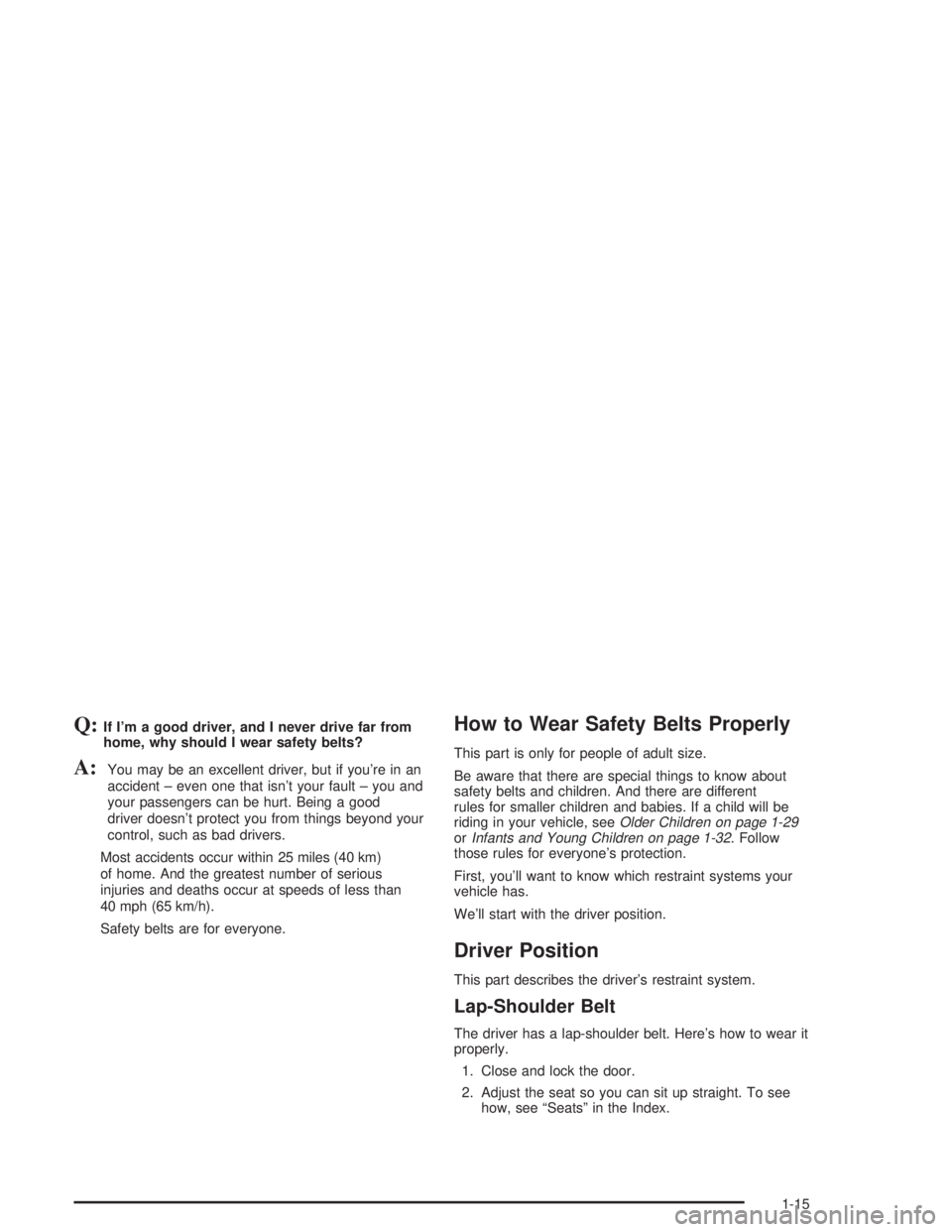
Q:If I'm a good driver, and I never drive far from
home, why should I wear safety belts?
A:You may be an excellent driver, but if you're in an
accident ± even one that isn't your fault ± you and
your passengers can be hurt. Being a good
driver doesn't protect you from things beyond your
control, such as bad drivers.
Most accidents occur within 25 miles (40 km)
of home. And the greatest number of serious
injuries and deaths occur at speeds of less than
40 mph (65 km/h).
Safety belts are for everyone.
How to Wear Safety Belts Properly
This part is only for people of adult size.
Be aware that there are special things to know about
safety belts and children. And there are different
rules for smaller children and babies. If a child will be
riding in your vehicle, see
Older Children on page 1-29orInfants and Young Children on page 1-32. Follow
those rules for everyone's protection.
First, you'll want to know which restraint systems your
vehicle has.
We'll start with the driver position.
Driver Position
This part describes the driver's restraint system.
Lap-Shoulder Belt
The driver has a lap-shoulder belt. Here's how to wear it
properly.
1. Close and lock the door.
2. Adjust the seat so you can sit up straight. To see
how, see ªSeatsº in the Index.
1-15
Page 29 of 432

The best way to protect the fetus is to protect the
mother. When a safety belt is worn properly, it's more
likely that the fetus won't be hurt in a crash. For
pregnant women, as for anyone, the key to making
safety belts effective is wearing them properly.
Right Front Passenger Position
To learn how to wear the right front passenger's safety
belt properly, seeDriver Position on page 1-15.
The right front passenger's safety belt works the same
way as the driver's safety belt Ð except for one
thing. If you ever pull the shoulder portion of the belt out
all the way, you will engage the child restraint locking
feature. If this happens, just let the belt go back all
the way and start again.
Rear Seat Passengers
It's very important for rear seat passengers to buckle
up! Accident statistics show that unbelted people in the
rear seat are hurt more often in crashes than those
who are wearing safety belts.
Rear passengers who aren't safety belted can be
thrown out of the vehicle in a crash. And they can strike
others in the vehicle who are wearing safety belts.
Rear Seat Passenger Positions
1-23
Page 53 of 432
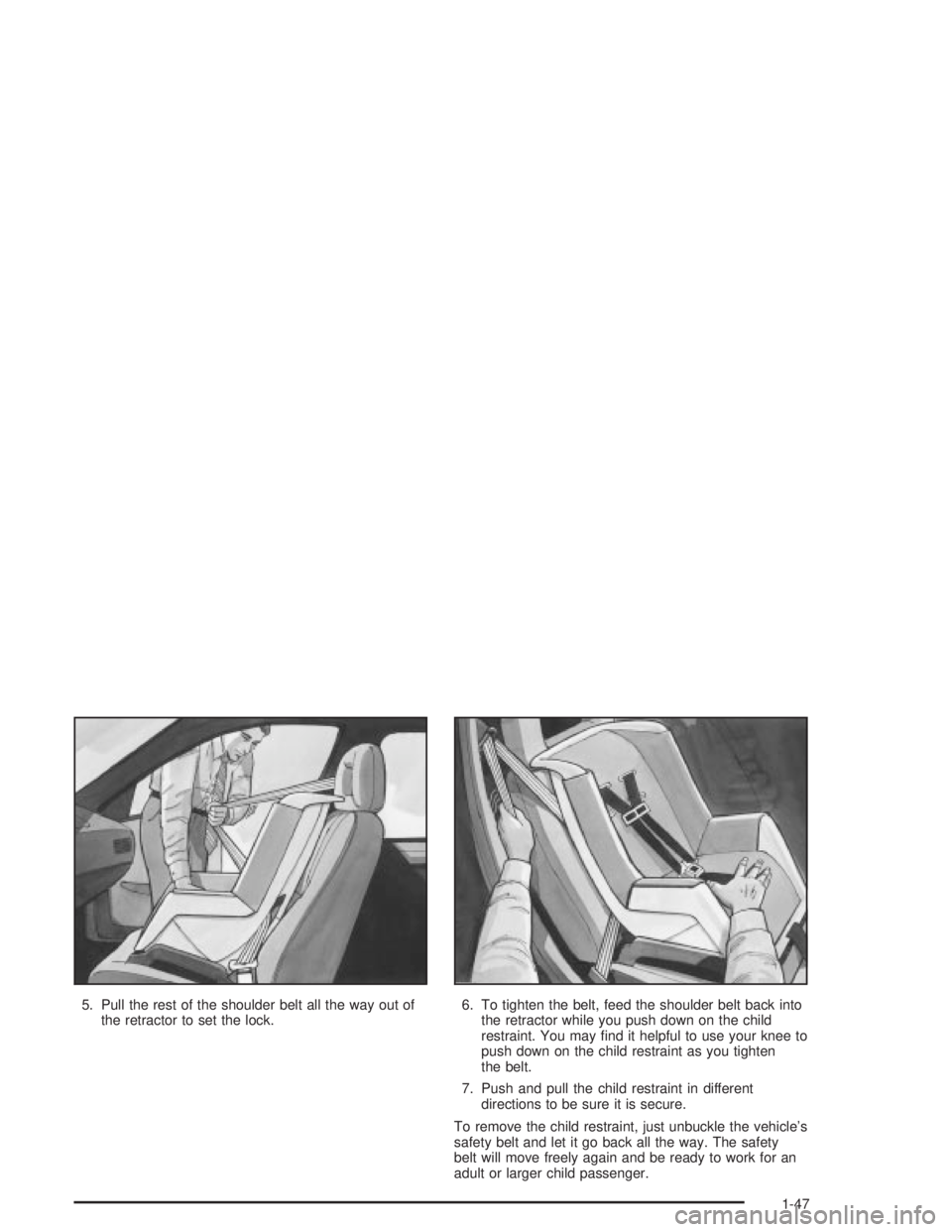
5. Pull the rest of the shoulder belt all the way out of
the retractor to set the lock.6. To tighten the belt, feed the shoulder belt back into
the retractor while you push down on the child
restraint. You may ®nd it helpful to use your knee to
push down on the child restraint as you tighten
the belt.
7. Push and pull the child restraint in different
directions to be sure it is secure.
To remove the child restraint, just unbuckle the vehicle's
safety belt and let it go back all the way. The safety
belt will move freely again and be ready to work for an
adult or larger child passenger.
1-47
Page 71 of 432
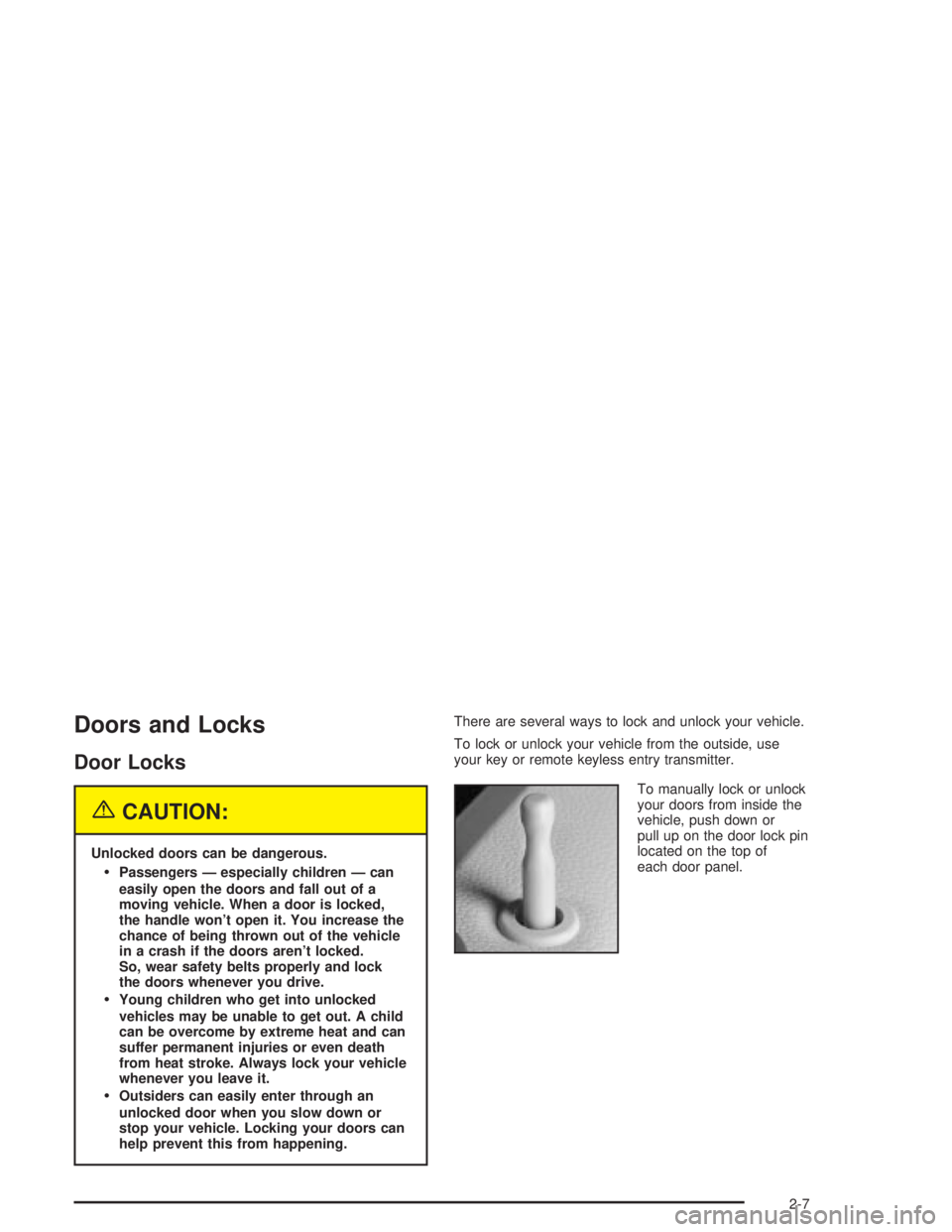
Doors and Locks
Door Locks
{CAUTION:
Unlocked doors can be dangerous.
·Passengers Ð especially children Ð can
easily open the doors and fall out of a
moving vehicle. When a door is locked,
the handle won't open it. You increase the
chance of being thrown out of the vehicle
in a crash if the doors aren't locked.
So, wear safety belts properly and lock
the doors whenever you drive.
·Young children who get into unlocked
vehicles may be unable to get out. A child
can be overcome by extreme heat and can
suffer permanent injuries or even death
from heat stroke. Always lock your vehicle
whenever you leave it.
·Outsiders can easily enter through an
unlocked door when you slow down or
stop your vehicle. Locking your doors can
help prevent this from happening.There are several ways to lock and unlock your vehicle.
To lock or unlock your vehicle from the outside, use
your key or remote keyless entry transmitter.
To manually lock or unlock
your doors from inside the
vehicle, push down or
pull up on the door lock pin
located on the top of
each door panel.
2-7
Page 251 of 432
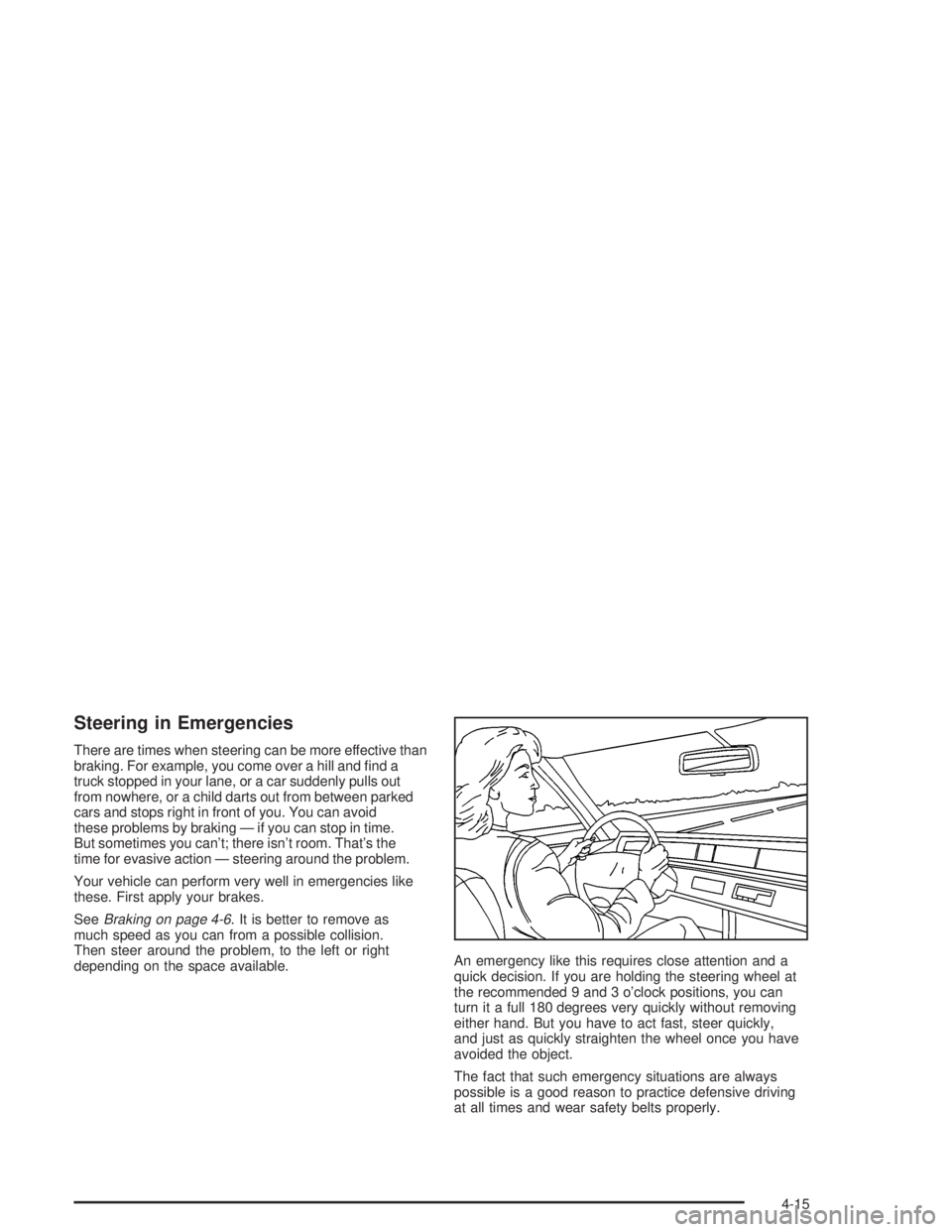
Steering in Emergencies
There are times when steering can be more effective than
braking. For example, you come over a hill and ®nd a
truck stopped in your lane, or a car suddenly pulls out
from nowhere, or a child darts out from between parked
cars and stops right in front of you. You can avoid
these problems by braking Ð if you can stop in time.
But sometimes you can't; there isn't room. That's the
time for evasive action Ð steering around the problem.
Your vehicle can perform very well in emergencies like
these. First apply your brakes.
See
Braking on page 4-6. It is better to remove as
much speed as you can from a possible collision.
Then steer around the problem, to the left or right
depending on the space available.An emergency like this requires close attention and a
quick decision. If you are holding the steering wheel at
the recommended 9 and 3 o'clock positions, you can
turn it a full 180 degrees very quickly without removing
either hand. But you have to act fast, steer quickly,
and just as quickly straighten the wheel once you have
avoided the object.
The fact that such emergency situations are always
possible is a good reason to practice defensive driving
at all times and wear safety belts properly.
4-15
Page 423 of 432
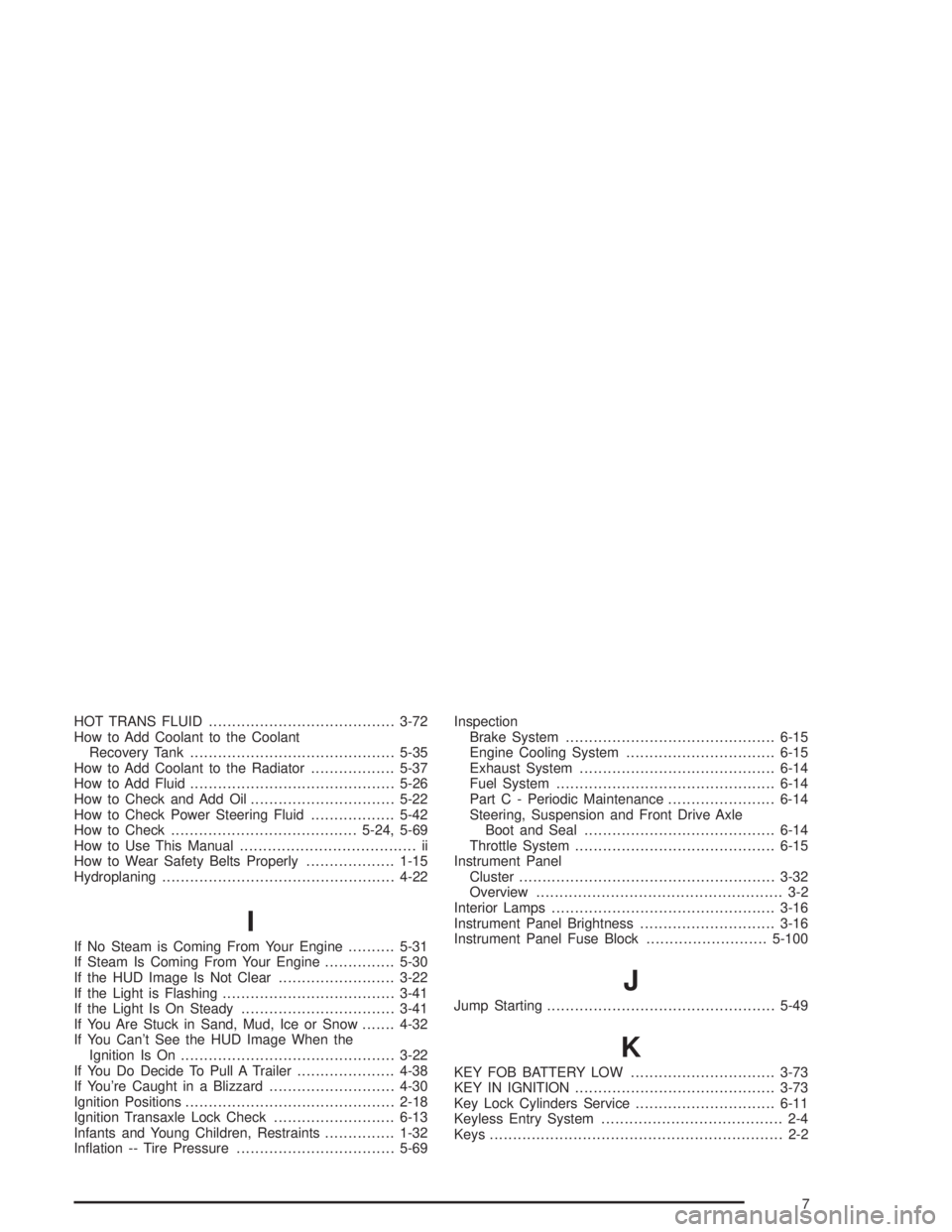
HOT TRANS FLUID........................................3-72
How to Add Coolant to the Coolant
Recovery Tank............................................5-35
How to Add Coolant to the Radiator..................5-37
How to Add Fluid............................................5-26
How to Check and Add Oil...............................5-22
How to Check Power Steering Fluid..................5-42
How to Check........................................5-24, 5-69
How to Use This Manual...................................... ii
How to Wear Safety Belts Properly...................1-15
Hydroplaning..................................................4-22
I
If No Steam is Coming From Your Engine..........5-31
If Steam Is Coming From Your Engine...............5-30
If the HUD Image Is Not Clear.........................3-22
If the Light is Flashing.....................................3-41
If the Light Is On Steady.................................3-41
If You Are Stuck in Sand, Mud, Ice or Snow.......4-32
If You Can't See the HUD Image When the
Ignition Is On..............................................3-22
If You Do Decide To Pull A Trailer.....................4-38
If You're Caught in a Blizzard...........................4-30
Ignition Positions.............................................2-18
Ignition Transaxle Lock Check..........................6-13
Infants and Young Children, Restraints...............1-32
In¯ation -- Tire Pressure..................................5-69Inspection
Brake System.............................................6-15
Engine Cooling System................................6-15
Exhaust System..........................................6-14
Fuel System...............................................6-14
Part C - Periodic Maintenance.......................6-14
Steering, Suspension and Front Drive Axle
Boot and Seal.........................................6-14
Throttle System...........................................6-15
Instrument Panel
Cluster.......................................................3-32
Overview..................................................... 3-2
Interior Lamps................................................3-16
Instrument Panel Brightness.............................3-16
Instrument Panel Fuse Block..........................5-100
J
Jump Starting.................................................5-49
K
KEY FOB BATTERY LOW...............................3-73
KEY IN IGNITION...........................................3-73
Key Lock Cylinders Service..............................6-11
Keyless Entry System....................................... 2-4
Keys............................................................... 2-2
7
Page 424 of 432
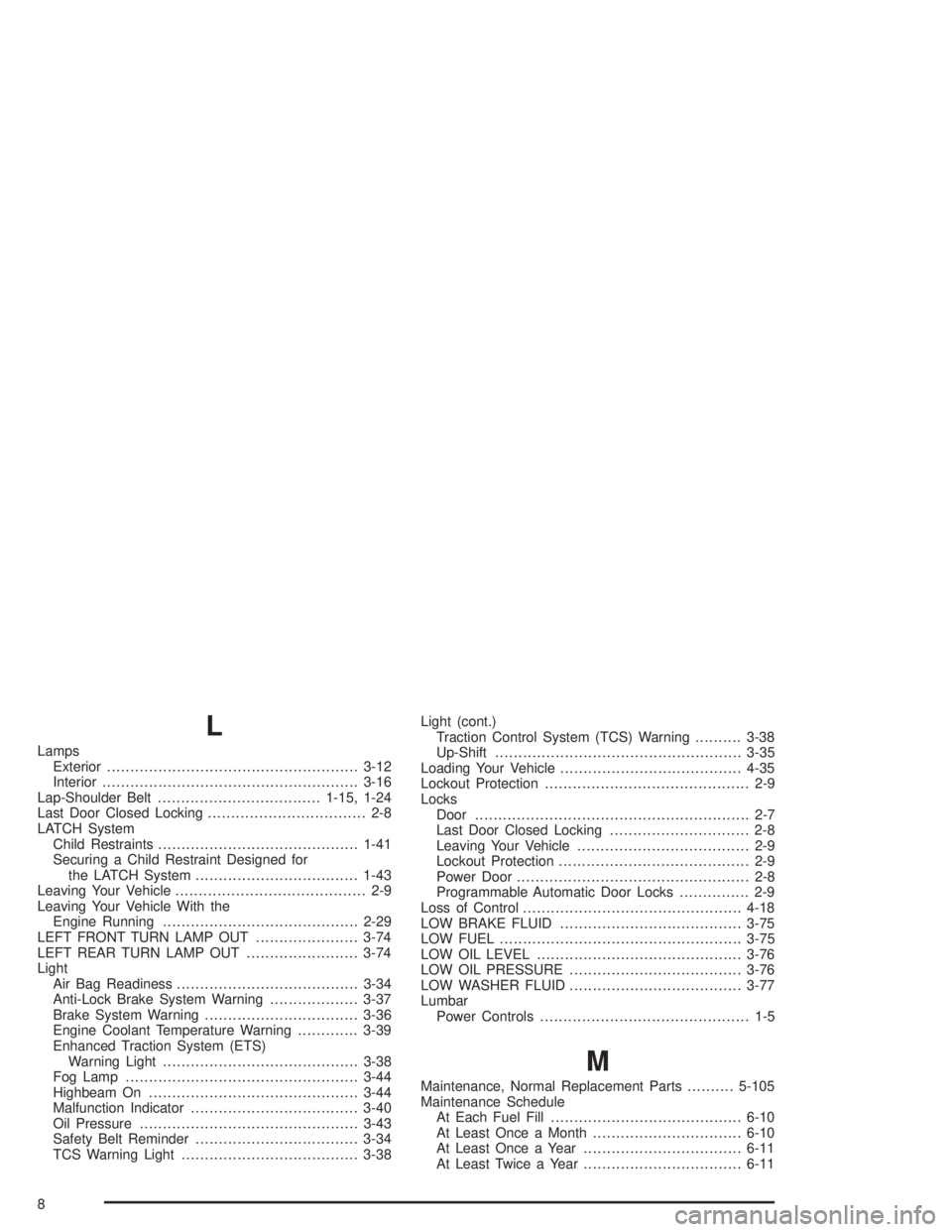
L
Lamps
Exterior......................................................3-12
Interior.......................................................3-16
Lap-Shoulder Belt...................................1-15, 1-24
Last Door Closed Locking.................................. 2-8
LATCH System
Child Restraints...........................................1-41
Securing a Child Restraint Designed for
the LATCH System...................................1-43
Leaving Your Vehicle......................................... 2-9
Leaving Your Vehicle With the
Engine Running..........................................2-29
LEFT FRONT TURN LAMP OUT......................3-74
LEFT REAR TURN LAMP OUT........................3-74
Light
Air Bag Readiness.......................................3-34
Anti-Lock Brake System Warning...................3-37
Brake System Warning.................................3-36
Engine Coolant Temperature Warning.............3-39
Enhanced Traction System (ETS)
Warning Light..........................................3-38
Fog Lamp..................................................3-44
Highbeam On.............................................3-44
Malfunction Indicator....................................3-40
Oil Pressure...............................................3-43
Safety Belt Reminder...................................3-34
TCS Warning Light......................................3-38Light (cont.)
Traction Control System (TCS) Warning..........3-38
Up-Shift.....................................................3-35
Loading Your Vehicle.......................................4-35
Lockout Protection............................................ 2-9
Locks
Door........................................................... 2-7
Last Door Closed Locking.............................. 2-8
Leaving Your Vehicle..................................... 2-9
Lockout Protection......................................... 2-9
Power Door.................................................. 2-8
Programmable Automatic Door Locks............... 2-9
Loss of Control...............................................4-18
LOW BRAKE FLUID.......................................3-75
LOW FUEL....................................................3-75
LOW OIL LEVEL............................................3-76
LOW OIL PRESSURE.....................................3-76
LOW WASHER FLUID.....................................3-77
Lumbar
Power Controls............................................. 1-5
M
Maintenance, Normal Replacement Parts..........5-105
Maintenance Schedule
At Each Fuel Fill.........................................6-10
At Least Once a Month................................6-10
At Least Once a Year..................................6-11
At Least Twice a Year..................................6-11
8